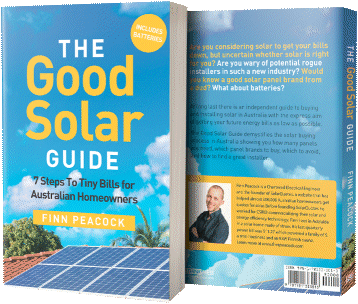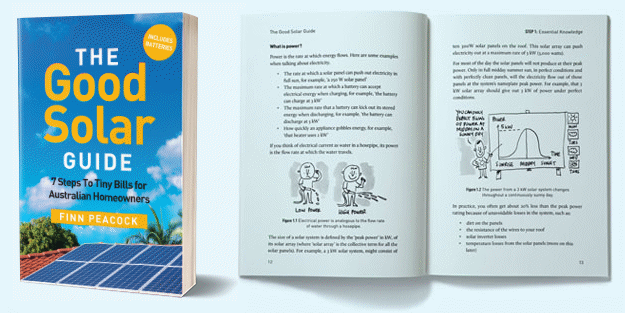If the idea of handing control of your home battery over to a Virtual Power Plant operator (VPP) doesn’t appeal to you, perhaps participating in a Virtual Energy Network (VEN) will.
The buzz about VPPs is building given the national Cheaper Home Batteries program requires batteries installed under the scheme to be VPP capable; although joining one isn’t compulsory. But VEN programs remain mostly out of the limelight.
The Difference Between A VPP And VEN
A Virtual Power Plant (VPP) is a system that aggregates and centrally controls a group of distributed energy resources such as solar panels and batteries to function like a single power plant. The VPP operator decides when to discharge participating batteries into the grid and when to charge them, in return providing some sort of benefit to the party hosting the battery. You can learn more about the pros and cons of Virtual Power Plants here, and compare VPP programs here.
A Virtual Energy Network (VEN) virtually connects energy consumers and producers such as solar/battery system owners through an online platform, allowing them to share or trade energy within a community, enterprise, or ecosystem (peer-to-peer trading).
There are a few VENs operating in Australia such as Enosi Powertracer via Energy Locals and LocalVolts; so let’s take a look at those.
Powertracer VEN
Energy Locals teamed up with Enosi to offer the Powertracer platform in the ACT, NSW, QLD, SA and VIC. It enables members to buy or trade excess solar energy generation with other members of the Energy Locals Powertracer community. The idea is producers (solar owners) can get more for their exports by setting the price for that electricity, and consumers pay less than usual retailer rates for that electricity.
Energy Locals’ rates and feed-in-tariffs under its Local Member plan apply when there are no available trading partners. In my case, at the time of writing, that would be a Time of Use (ToU) plan:
- Membership: $21.49/month
- Daily supply charge: 127.00 c/day
- Consumption: Peak: 41.50 c/kWh , Off Peak: 31.00 c/kWh , Shoulder (Solar Sponge): 25.50 c/kWh
- Feed-in tariff rates: Peak: 15.00 c/kWh, Off Peak: 5.00c/kWh, Solar Sponge 2.00 c/kWh.
(Peak: 6:00am to 9:59am and 4:00pm to 11:59pm, Off-peak 12:00am to 5:59am, Shoulder/Solar Sponge: 10:00am to 3:59pm)
By the way, you don’t have to sell your surplus. If you’re feeling particularly generous, you can gift it to family and friends — but they’ll need to be on the PowerTracer platform too.
There are no exit fees or lock-in contracts with PowerTracer VEN.
Deakin University is carrying out a study evaluating the benefits of peer-to-peer trading of excess rooftop solar energy between customers, and is inviting Energy Locals Enosi Powertracer Plan members to participate.
LocalVolts VEN
LocalVolts is another electricity marketplace where you can buy and sell electricity from/to others. Residential and business customers in the ACT, New South Wales, Queensland, South Australia and Tasmania can participate in selling and buying to/from:
- The wholesale market.
- The peer-to-peer market at prices you set.
- A chosen customer at an agreed price.
You’ll need to switch to LocalVolts as your electricity retailer.
For residential customers, it costs $1.10 per day participate, and that’s just about it from the LocalVolts end1. All other prices, costs and charges, including those charged by the local distributor for accessing the electricity network are applied on a pass-through basis.
LocalVolts’ VEN wouldn’t be for the faint-of-heart, reportedly can be fiddly to set up and requires some ongoing effort.
For both buyers and sellers, during periods where buy/sell preferences are not set (or met), their electricity is purchased from or sold to the wholesale electricity spot market.
Wholesale electricity market rates can go as high as $20.30 per kilowatt-hour this financial year during extreme events, which is the National Electricity Market’s (NEM’s) market price cap (MPC). But when pricing is negative — something becoming more common in some regions2 — you’ll be paid to consume. However, you’ll pay to export solar electricity when wholesale prices are negative.
There are no lock-in contracts or exit fees with LocalVolts’ VEN.
Without actually participating and seeing a VEN in practice, it’s hard to gauge how good (or otherwise) being part of one could be, but the Deakin PowerTracer study will shed light on some of the pros and cons of VEN participation. Both these services have their fans and critics, and perhaps LocalVolts/Powertracer members will weigh in with their experiences in the comments section below.
Added: I just became aware of a study via a news release published on UniSA’s website today after this article was published from Deakin Uni/Uni SA titled: “Technical and economic analyses of grid-connected residential PV considering batteries and peer-to-peer energy sharing”, but haven’t looked through the study yet.
Another alternative that isn’t a VEN, but isn’t quite a VPP (although considered as such under some rebate schemes) is Amber for Batteries. We’ve written quite a bit about Amber over the years, so I’ll leave it to someone who’s actually using the service (SolarQuotes’ Jono) to share his Amber experience.
Footnotes
- LocalVolts says the Australian Energy Market Operator (AEMO) requires all retailers to provide bank guarantees and cash deposits to cover energy purchases from the wholesale spot market. LocalVolts will identify the credit support needed to support a member’s energy purchases, and the costs associated with providing that capital to the AEMO is charged to the member. ↩
- According to the Australian Energy Regulator, there were 612 more negative price events during Q2 2025 compared with the same time last year due to periods of high rooftop solar output, and boosted wind and large-scale solar generation. ↩


 RSS - Posts
RSS - Posts



I recently tried to join the Deakin Uni Powertracer VEN, but I was unable to join thanks to my unusual situation. I was already an Energy Locals customer, having previously bought into the Haystacks Community Solar Garden. I get ongoing credits on my Energy Locals electricity account in return for buying a “plot” in the solar garden.
Unfortunately Energy Locals said they can’t manage the same customer getting Haystacks account credits, while also participating in the Powertracer VEN – it’s either one or the other. This is very disappointing. I hope that Energy Locals can improve their processes to allow a customer to do both.
A far better idea than the currently available VPP’s, as i understand great if you own multiple properties, you can basically use your own solar at a different location.
But not for me – even with a 20kwh battery i use most of my generated power, and I want my power available for me at night. They only want to charge when power is at its cheapest for them, and that is when my battery is already full with the output from my roof top solar.
Very Timely, Last Saturday I started the move to Localvolts and got an instant response from the webform handler, but nothing since. That said new Sigenergy 24kwh battery has been installed but the 19kw of PV is sitting on the back veranda while we wait for the last coat of Dulux Acratex to dry on the tin roof. Panels should be installed next week. My current retailer is looking somewhat unappealing right now. I’m not sure if the paperwork that will ultimately follow the completed install is somehow holding things up at a retailer level, but I personally don’t know other than the whole STC thing what info relating to batterys and size of solar etc is shared between CEC/CER processes and Government and retailers and utilitys
Andy
I had a look at the Powertracer plan for the ACT and it does not support time of use supply so all supplied electricity is at peak rate and there is a demand charge on top.
Gordon, Energy Locals pricing for ACT appears to be now the same as NSW & Powertracer does facilitate setting up Time of Use trades. I’ve just set some up myself-confusingly the times are set up under Flat Rate settings for 3 time periods.
This is a fast moving space, so much happening!
A truly efficient and competititve system would deliver energy to all at close to cost. The massive price spikes we see on the grid do not reflect costs, but rather intermittent ‘competition outages’ and economists will explain why marginal pricing flips to the highest cost of production like it’s a good thing in a working market, rather than admit it’s just sickeningly regular market failure.
Equally, your neighbour paying full whack for your dirt cheap exports is a market failure.
Moving right along, if you have your own solar & battery and run an optimiser that chooses between the cheapest imports and self utilisation and most lucrative exports, VENs and the grid would eventually converge and VPPs would become obsolete unless they could offer you a better optimiser than your own.
Early days, but DER/CER could be a revolution the oligopolists can’t control as consumers stop getting mad and start getting even …
I think that if you look at how the oligopolists (gentailers) have stopped investing in utility solar and wind generation and going all in on batteries suggests that they might fear such a revolution too. They are building big batteries at pace and are urging regulators in any way that can force home batteries into their VPPs (also having bought Tesla’s VPP).
There is something of a (revolutionary) battle on to see if they can keep control of the very profitable peak price windows and the ability to gorge on occasional engineered big wholesale price spikes.
Hi OB,
I suspect the permisssion, preparation, build time & cost of expansive new generation is pretty onerous.
Batteries might not be outright cheap but they’re quick, easy and profitable.
The “benign” hand of the free market needs some government guidance to think long term.
Sadly the political terms are short, the public service is outsourced to consultancies & the public utilities have been flogged off.
DNSPs will just keep raising their supply fee. We’re approaching $3/day (1k/year) here in regional NSW.
So the move to Localvolts went through and I have a few days usage data where I tried managing my costs by using power when the duck curve was at its lowest point, where supply exceeded demand. For yesterday my total daily costs were $4.40 the actual energy usage costs subset of that amount was $0.42 for 17.07kwh the rest were mandated government, DNSP and retailer charges.
When it gets to the point that just 10% of the costs can be actually be avoided then further progress is going to be limited hey!
At the same stage my old retailer red energy using TOU charges for the same day assuming 100% of the 17.07kwh were off peak would have cost me more than $7 so the move was worth making….
I haven’t tried selling anything back yet, the spot prices over the weekend weren’t enough to justify discharging the battery…which is a good thing for the greater country.
Andy S – here did the 17.07kWh for 42c come from? Thats only 2.46c/kWh!
Correct that’s the average spot price and in the middle of a sunny day the spot price is about 0c or minus 2c. But if i use an analogy that’s farm gate price and you then have to pay to have it delivered to you as well as some taxes on the way…
If you have a battery and snowy 2 isn’t yet set up and working (which is designed to use the midday glut) then spot price in AU on good weather days is going to be nothing. You can max out on nothing (which isn’t nothing after all the extras are paid for) and timeshift it to later
Andy
Deakins Virtual Energy Network Study is still open for participants.
The link for more info is below:
https://www.deakin.edu.au/faculty-of-business-and-law/research/virtual-energy-network
Don’t miss out, closing soon – join now!
It’s great research that aims to:
– Understand and measure the potential benefits of VEN energy trading, including to consumers and grid operators.
– Boost lower cost solar energy consumption in the middle of the day.
– Help consumers maximise value for their solar generation.
– Enable better utilisation of solar within household and small business communities.
Have been with Energy Locals / Enosi Powertracer for a while now and it seems to be very good. I’m getting some very good rates for selling my power peer-to-peer. Winter wasn’t wonderful, but still a lot better than being on the “local” provider Red Energy.
We’re in an alpine region so we produce way more than we use in summer but kinda the opposite in winter.
Planning to get battery soon so will be interesting to see how this goes. I prefer the VEN over the VPPs I’ve looked at – but this could change.
Im with Localvolts. I have a sigenergy.24kw battery and have set my system up with Home Assistant automation so that i export on excess PV when the rates are >1c kwhr, but can set this to whst ever i want it to be. Arguably 1c is me going backward, i sell from battery when rates excdeed 30c per kwh. My monthly country nsw cost for Nov is up to today 29th $-5 due to 2 relatively short period where we got to about $20 per kwh. They arent that common though and are more a bonus than to be relied upon. The HA/Node red automation wasnt too difficult to set up and im happy to provide help.if anyone eants it, but itll be limited to sigenery modbus control and localvolts api where you get the curtent financials from against which you determine what you do….Andy
Thanks Andy,
We’d love to hear more about it.
Do you have some good beginners guides for people to start with?